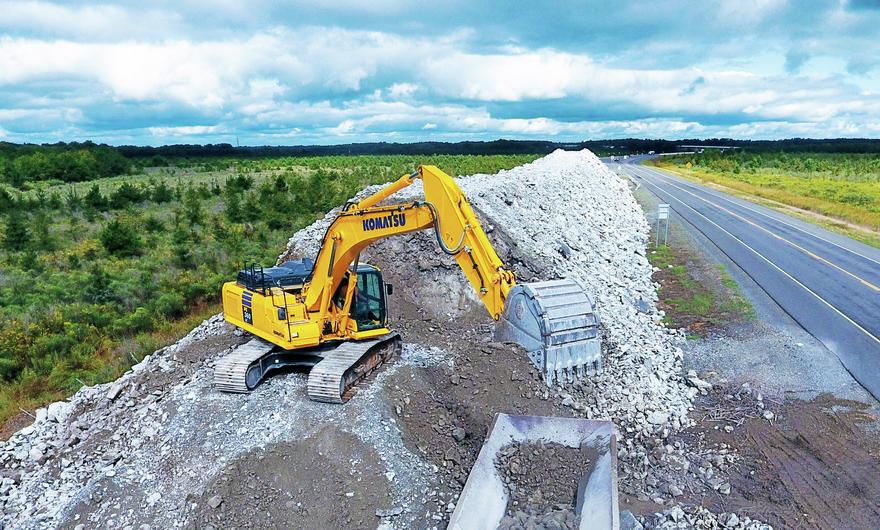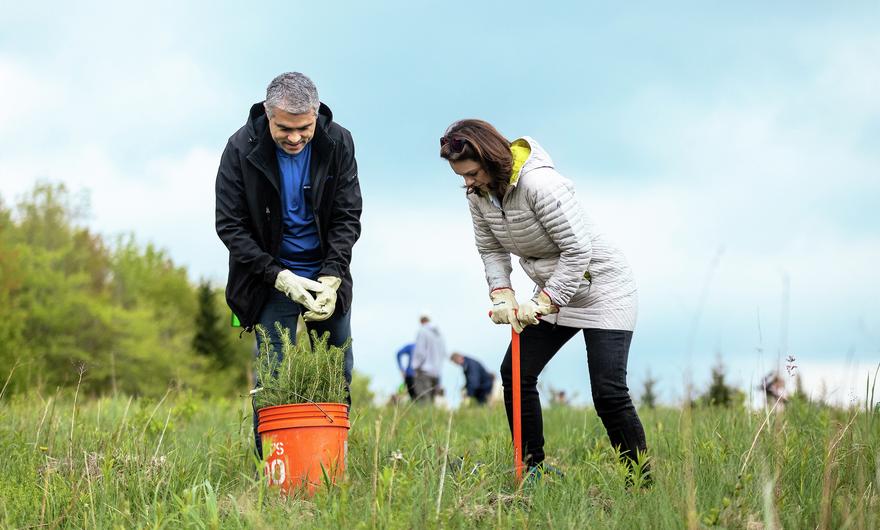3 min read
Komatsu supports reforestation at New River Gorge National Park and Preserve
- Sustainability,Blog,Social responsibility
9 min read

“Green” is a trending adjective for a practice construction companies have been following for years. Before it became the norm to recycle, construction companies were recycling construction and demolition (C&D) debris, including steel, asphalt and concrete. As an industry that works directly with the land, many have understood the importance of protecting it through sustainable practices.
Recycling C&D debris has multiple environmental benefits. Decreasing the amount of virgin materials that need to be mined and then trucked from quarries and aggregate pits to job sites reduces both emissions and your carbon footprint.
While these are important practices for protecting the earth, are you aware of the increasingly wide variety of ways sustainability efforts can boost your company’s value overall? Green practices can help reduce material costs, increase employee retention and ultimately boost profitability as supply chain partners and customers see you as a company worth working with for reasons beyond the traditional requirements.
Here are four ways thinking more sustainably could help boost your bottom line.
Lower costs
According to the United States Environmental Protection Agency (EPA), sustainability is based on a simple principle: Everything that we need for our survival and wellbeing depends, either directly or indirectly, on our natural environment. To pursue sustainability is to create and maintain the conditions under which humans and nature exist in productive harmony to support present and future generations.
Many new construction projects are done on sites where removing old materials like pavement, foundations and brick and concrete are part of the job. Recycling and reusing these materials on-site can provide significant savings.
 Recycling and reusing materials such as old pavement on-site reduces transportation costs and potentially increases profits while benefitting the environment through lowered emissions.
Recycling and reusing materials such as old pavement on-site reduces transportation costs and potentially increases profits while benefitting the environment through lowered emissions.
Using recycled materials reduces the need to purchase virgin aggregates and the trucking costs associated with bringing them to the job site. It also reduces the need to transport C&D debris off-site, as well as the potential fees to put it in a landfill. Less fuel use and reduced wear and tear on trucks lowers repair and replacement costs for consumable items such as brakes and tires.
In some cases, old materials can’t be reused on-site and still have to be hauled off. These can still have significant value. That’s why numerous companies have set up recycling yards that accept C&D waste and turn it into new products
One of the earliest adopters of the practice is Houston, Texas-based Cherry Companies. Thirty years ago, Cherry Demolition began recycling when they had an abundance of raw concrete that they wanted to keep out of landfills. Cherry Crushed Concrete was formed with two stationary plants. Then, a road removal division was added to secure materials from road projects. Because so many customers wanted their concrete to stay on-site, the company added Cherry Portable Crushing.
“The bulk of what we make at our recycling centers is flex base, which is approved by the Texas Department of Transportation for use as road base,” said Vice President Ivan Svec, who oversees crushing. “It’s a very cost-effective alternative to natural aggregates – which could be said about every product we make from recycled concrete and asphalt.”
In addition to flex base, Cherry produces “bullrock,” blanket stone, rip rap, screened rock and fines from crushed concrete. It makes specialty aggregates from recycled asphalt pavement and asphalt shingles. In total, it recycles more than 2 million tons of concrete annually, as well as close to 30,000 tons of reclaimed asphalt in addition to steel, shingles and tires.
“We can create specialty products that meet unique specifications,” said Svec. “Our portable operations produce a fair number of products too, including many of the same materials that our recycling centers do. The advantage in those situations is that they don’t have to be transported out or in, which reduces transportation costs.”
PG Enterprises LLC offers similar services in and around Albuquerque, New Mexico. Owner Payam Ghoreishi started with mobile crushing about 23 years ago when he was offered a project to dismantle a large dairy operation that included concrete removal and disposal.
“I figured the concrete would get hauled to the landfill, but the question of crushing/recycling came up,” recalled Ghoresishi. “I had been to Germany and saw that contractors there recycled practically everything, and I believed the best move would be to bring in a mobile unit and crush there. I put a proposal together that included doing that with the idea that the resulting material would stay on-site, used as backfill or be sold with the property – turn the liability into an asset, so to speak.”
Ghoreishi is still recycling concrete and has added asphalt. Old pavements and foundations come from locations where PG Enterprises’ dirt crews are performing demolition as part of site work services that include clearing and grubbing, mass excavation and fine grading. On the southeast side of Albuquerque, truck drivers for PG Enterprises deliver concrete and asphalt to the company’s recycle yard which the company turns into several “new” products.
Even traditional aggregate operations have added recycling such as sand, gravel and concrete supplier, Aggregate Industries of Moorhead, Minn. “There are environmental benefits to the process of recycling concrete, and it creates a circular economy of reusing a product that would previously have taken up space in a landfill,” said Justin Flack, general manager, north central region. “Recycling material also means we’re pulling fewer resources out of the earth and reducing the industry’s environmental impact.”
Attracting and retaining top talent
Employee turnover is costly. By some estimates, it equates to 1.5 to 2 times an employee’s salary when you factor in advertising, training and lost productivity. While you may not have considered it, reducing your environmental impact could be a key to lowering those workforce costs, retaining existing talent and attracting new employees, especially younger workers.
Nearly 70% of millennials have said they prefer to work for a company with a strong sustainability agenda, while 75% said they were willing to take a smaller salary to work for an environmentally responsible firm.
 Studies show today’s workforce takes corporate responsibility and sustainable business practices into account when choosing an employer. In this photo, Komatsu executives help plant trees for a corporate reforestation project in West Virginia. “Prospective employees want to know about your community involvement and how you’re giving back…,” said Komatsu’s Caley Clinton, senior manager – PR, CSR and content.
Studies show today’s workforce takes corporate responsibility and sustainable business practices into account when choosing an employer. In this photo, Komatsu executives help plant trees for a corporate reforestation project in West Virginia. “Prospective employees want to know about your community involvement and how you’re giving back…,” said Komatsu’s Caley Clinton, senior manager – PR, CSR and content.
“There are numerous surveys that show that younger employees want to work for companies that demonstrate they are committed to sustainability,” said Komatsu’s Caley Clinton, senior manager – PR, CSR and content. “That includes on the job site, as well as in the office through practices such as reducing paper, water and electricity use. Prospective employees also want to know about your community involvement and how you’re giving back in ways that contribute to environmental improvements such as donating equipment, time and labor to projects like tree planting.”
Clinton added that it’s important for companies to highlight their sustainable practices in prominent ways so that they stand out to prospective employees.
“Having a section of your website dedicated to what you are doing to reduce your carbon footprint and water usage should seriously be considered,” Clinton indicated. “Pictures showing your efforts are helpful. Icons such as the recycling symbol that show your commitment to green practices should be prominent on all your materials, including recruiting items, company brochures and other marketing items. It’s an essential part of your brand’s value, as long as it is actually a part of your company’s culture.”
Better worker productivity
Healthy workers are more productive, but because construction workers generally work outdoors, they can be more susceptible to pollution that can lead to illnesses and diseases.
A recent study by scientists at Duke University, NASA and Columbia University showed that acting now to reduce fossil fuel use would result in improved air quality and dramatic reductions in pollution-related deaths, illnesses and economic losses across the United States by 2030.
The study found that due to heat exposure or pollution-related respiratory illnesses, about 4.5 million premature deaths, 1.4 million hospitalizations and emergency room visits, and 300 million lost workdays could be prevented nationwide. But to do so, governments worldwide need to agree to immediately begin reducing emissions to levels needed to meet the Paris Agreement’s goal of limiting global warming to 2 degrees Celsius through the end of the century.
The benefits of sustainable practices include cleaner air and fewer sick days related to environmental factors. In turn, when productivity increases, it can lead to increased profits.
Landing more jobs
Landing more jobs will increase profitability, too. Just as employees want to work for businesses committed to sustainability, other companies want to work with those who emphasize greener businesses practices. In many cases, companies or governments are making it a requirement to work on their projects.
“Companies that advance their approach to sustainability now can get the benefit of doing it for the right reasons, being on the forefront of the curve and helping lead the way in their industries,” Clinton emphasized. “If you wait until it’s required and have to submit a report to a customer or another contractor you want to work with – and only then realize you don’t have all the requirements, you may be at a disadvantage in the near future.”
Many governmental contracts already have sustainability built in, such as stipulations to procure environmentally friendly products and using equipment with lower emissions. They may also have stipulations to capture and retain stormwater to reduce runoff or set aside land for parks, trails and wetlands to offset construction of new roads.
Tips to get started
Clinton said measuring your sustainability is going to be increasingly more essential and it’s never been easier to do.
“There are many companies with software that help track practically everything you do related to sustainable practices,” Clinton noted. “Right now, that’s mostly at a nice-to-have level, but as more and more requirements are built into regulatory aspects of how companies have to do business, it’s going to be essential. Those who don’t have those metrics are probably going to miss most, if not all, opportunities. Those that do will likely land more jobs.”
Plan A claims to be the first software that enables businesses to monitor and reduce their emissions, while improving their ESG (Environmental, Social and Governance) performance. It lays out “10 steps you can take to start the sustainability conversation in your office.” Among them are: highlight the company value created by becoming sustainable, define the competitive advantage/market value of being sustainable, help management plan events such as participation in Earth Day, create a “green team” and identify all areas of improvement in your company.
“The most genuine place to start is within your company’s practices,” said Clinton. “You have to look at your own practices and find quick wins, areas and needs for significant improvement in key areas such as emissions, water usage, waste reduction and increasing use of renewables. You don’t have to do them all at once, but you have to get started. Not only will it benefit the environment, but your business, too.”